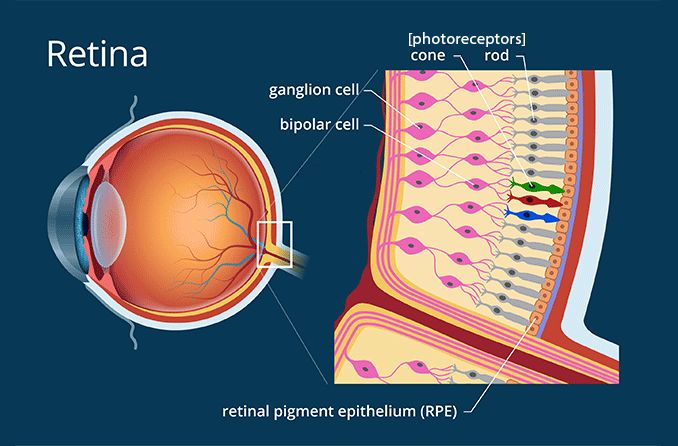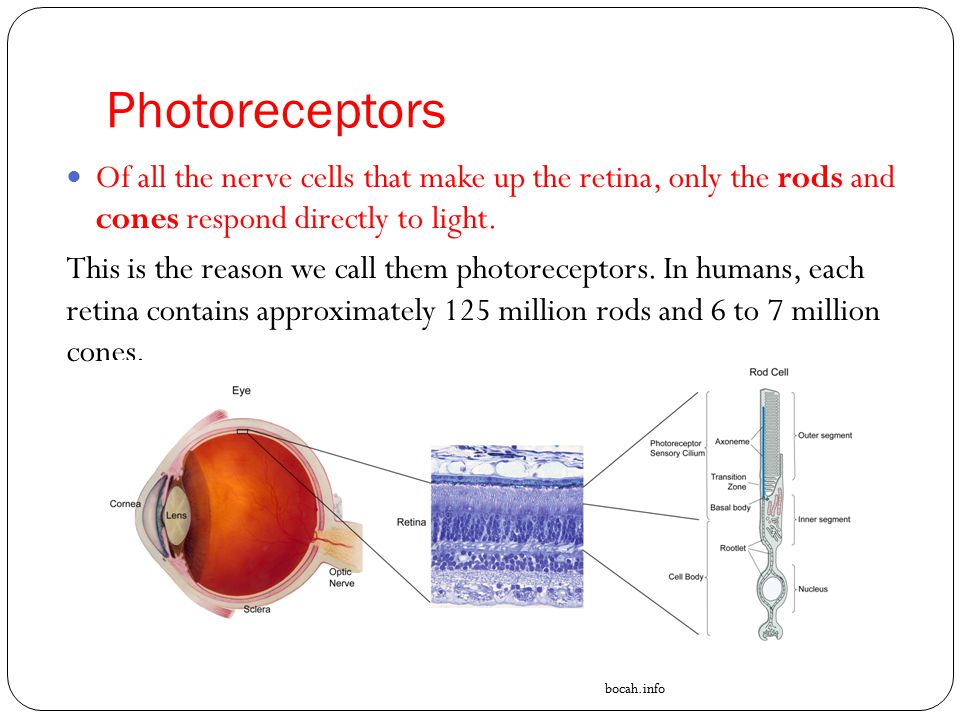Your What are the types of photoreceptors and their functions images are ready in this website. What are the types of photoreceptors and their functions are a topic that is being searched for and liked by netizens today. You can Download the What are the types of photoreceptors and their functions files here. Find and Download all royalty-free photos and vectors.
If you’re searching for what are the types of photoreceptors and their functions images information related to the what are the types of photoreceptors and their functions topic, you have visit the right site. Our website always gives you hints for viewing the highest quality video and image content, please kindly surf and find more informative video articles and graphics that fit your interests.
What Are The Types Of Photoreceptors And Their Functions. The visual pigment consists of a protein called opsin and a chromophore derived from vitamin A known as retinal. Cone photoreceptors are morphologically and functionally distinct from rods and express several types of visual pigments or opsins whose spectral sensitivity varies based on the cones subtype. The central fovea is populated exclusively by cones. These properties reflect the fact that the rod and cone systems the receptors and their connections within the retina are specialized for.
 Photoreceptor Cells Point To Intelligent Design From reasonandscience.catsboard.com
Photoreceptor Cells Point To Intelligent Design From reasonandscience.catsboard.com
Cone photoreceptors and rod photoreceptors. Rods cones and intrinsically photosensitive retinal ganglion cells. Stimulated by light energy. What are the four types of sensory receptors for the general senses. They do not mediate color vision and have a low spatial acuity. Vertebrate photoreceptors can respond to light by virtue of their containing a visual pigment embedded in the bilipid membranous discs that make up the outer segment.
The fundamental-and as yet imperfectly answered-question is how is this achieved at the molecular level.
We adopt the perspective of biophysi. Structure and function of plant photoreceptors Annu Rev Plant Biol. What are 2 types of photoreceptors. A photoreceptor usually com-prises a number of discrete protein items generally known as modules or domains every of which varieties a co-valentlyconnectedcompactlyfoldedportionof the sequence. Stimulated by light energy. Tap card to see definition.
 Source: pinterest.com
Source: pinterest.com
There are currently three known types of photoreceptor cells in mammalian eyes. Photoreceptors are the cells within the retina that reply to mild. They act as a type of pupil protecting the rhabdom in bright conditions by absorbing light. There are two kinds of photoreceptors. There are currently three known types of photoreceptor cells in mammalian eyes.
 Source: tr.pinterest.com
Source: tr.pinterest.com
The two classic photoreceptor cells are rods and cones each contributing information used by the visual system to form a representation of the visual world sight. Two types of photoreceptors reside in the retina. The following points highlight the seven main types of photoreceptors of photosynthetic pigments. Rods are extremely sensitive to light being able to detect and signal the absorption of a single photon. 2 3 4 At variance with other proteins what is compelling in photoreceptors is a detailed knowledge of the chromophore local environment namely.

Click card to see definition. There are currently three known types of photoreceptor cells in mammalian eyes. The visual pigment consists of a protein called opsin and a chromophore derived from vitamin A known as retinal. Click card to see definition. The fundamental-and as yet imperfectly answered-question is how is this achieved at the molecular level.
 Source: sk.pinterest.com
Source: sk.pinterest.com
The visual pigment consists of a protein called opsin and a chromophore derived from vitamin A known as retinal. Signaling photoreceptors use the information contained in the absorption of a photon to modulate biological activity in plants and a wide range of organisms. Rods and cones are structurally compartmentalised. There are two types of photoreceptors. S-cones M-cones and L-cones see Chapter 12 Color vision and night vision.
 Source: cz.pinterest.com
Source: cz.pinterest.com
The cones are responsible for daytime vision while the rods respond under dark conditions. Rod and cone Rods and cones are photoreceptive. In humans three classes of cones confer robust color vision. They are responsible for dim-light vision. Highly sensitive to minimal light allows us to see at night shapes and movement rhodopsin split into opsin and retinene in photon of lightopsin and retinene turn ATP into ADP and combine back to make rhodopsin.
 Source: foundationsofvision.stanford.edu
Source: foundationsofvision.stanford.edu
Blue-light receptors those that absorb blue. The fundamental-and as yet imperfectly answered-question is how is this achieved at the molecular level. Photoreceptors are special cells in the eyes retina that are responsible for converting light into signals that are sent to the brain. The two classic photoreceptor cells are rods and cones each contributing information used by the visual system to form a representation of the visual world sight. Photoreceptors in the retina are classified into two groups named after their physical morphologies.

Photoreceptors are the cells within the retina that reply to mild. Vertebrate photoreceptors can respond to light by virtue of their containing a visual pigment embedded in the bilipid membranous discs that make up the outer segment. Rods are responsible for vision at low light levels scotopic vision. Rod and cone Rods and cones are photoreceptive. The following points highlight the seven main types of photoreceptors of photosynthetic pigments.
 Source: es.pinterest.com
Source: es.pinterest.com
Rods cones and intrinsically photosensitive retinal ganglion cells. Tap card to see definition. These cells function by sensing light andor color and delivering the message back to the brain through the optic nerve. Rods are responsible for vision at low light levels scotopic vision. The two types of photoreceptors rods and cones are distinguished by shape from which they derive their names the type of photopigment they contain distribution across the retina and pattern of synaptic connections Figure 118.
 Source: researchgate.net
Source: researchgate.net
Cones are active at higher light levels photopic vision are capable of color vision and are responsible for high spatial acuity. Cone photoreceptors and rod. There are currently three known types of photoreceptor cells in mammalian eyes. Cone photoreceptors and rod photoreceptors. The central fovea is populated exclusively by cones.
 Source: allaboutvision.com
Source: allaboutvision.com
My DashboardMy EducationFind an Ophthalmologist Home For Ophthalmologists. There are two types of photoreceptors in the human retina rods and cones. What are the two types of photoreceptors and their functions. They do not mediate color vision and have a low spatial acuity. Signaling photoreceptors use the information contained in the absorption of a photon to modulate biological activity in plants and a wide range of organisms.
 Source: pinterest.com
Source: pinterest.com
There are two types of photoreceptors in the human retina rods and cones. What are the four types of sensory receptors for the general senses. The four types of general sensory receptors and the stimuli that excite them are nociceptors pain thermoreceptors temperature mechanoreceptors physical distortion and chemoreceptors chemical con- centration. The vitamin A is manufactured from beta-carotene in the food we eat and the protein is. Cone photoreceptors and rod.
 Source: pinterest.com
Source: pinterest.com
There are two types of photoreceptors in the human retina rods and cones. Signaling photoreceptors use the information contained in the absorption of a photon to modulate biological activity in plants and a wide range of organisms. What are 2 types of photoreceptors. Photoreceptors in the retina are classified into two groups named after their physical morphologies. Tap card to see definition.
 Source: researchgate.net
Source: researchgate.net
We adopt the perspective of biophysi. Rods are responsible for vision at low light levels scotopic vision. The four types of general sensory receptors and the stimuli that excite them are nociceptors pain thermoreceptors temperature mechanoreceptors physical distortion and chemoreceptors chemical con- centration. There are two types of photoreceptors. There are currently three known types of photoreceptor cells in mammalian eyes.
 Source: kenhub.com
Source: kenhub.com
Signaling photoreceptors use the information contained in the absorption of a photon to modulate biological activity in plants and a wide range of organisms. Highly sensitive to minimal light allows us to see at night shapes and movement rhodopsin split into opsin and retinene in photon of lightopsin and retinene turn ATP into ADP and combine back to make rhodopsin. Blue-light receptors those that absorb blue. Cone photoreceptors are morphologically and functionally distinct from rods and express several types of visual pigments or opsins whose spectral sensitivity varies based on the cones subtype. They act as a type of pupil protecting the rhabdom in bright conditions by absorbing light.
 Source: pinterest.com
Source: pinterest.com
Cone photoreceptors are morphologically and functionally distinct from rods and express several types of visual pigments or opsins whose spectral sensitivity varies based on the cones subtype. Stimulated by light energy. Rods and cones are structurally compartmentalised. The two classic photoreceptor cells are rods and cones each contributing information used by the visual system to form a representation of the visual world sight. Highly sensitive to minimal light allows us to see at night shapes and movement rhodopsin split into opsin and retinene in photon of lightopsin and retinene turn ATP into ADP and combine back to make rhodopsin.
 Source: pinterest.com
Source: pinterest.com
Cones are active at higher light levels photopic vision are capable of color vision and are responsible for high spatial acuity. The fundamental-and as yet imperfectly answered-question is how is this achieved at the molecular level. Types and Functions Plants have two different types of photoreceptors to perceive different waves of light. Vertebrate photoreceptors can respond to light by virtue of their containing a visual pigment embedded in the bilipid membranous discs that make up the outer segment. They do not mediate color vision and have a low spatial acuity.
 Source: reasonandscience.catsboard.com
Source: reasonandscience.catsboard.com
Cones are active at higher light levels photopic vision are capable of color vision and are responsible for high spatial acuity. Photoreceptors are the cells within the retina that reply to mild. Rods are responsible for vision at low light levels scotopic vision. They act as a type of pupil protecting the rhabdom in bright conditions by absorbing light. What are the four types of sensory receptors for the general senses.
 Source: slideplayer.com
Source: slideplayer.com
There are two types of photoreceptors. What are 2 types of photoreceptors. Cone photoreceptors are morphologically and functionally distinct from rods and express several types of visual pigments or opsins whose spectral sensitivity varies based on the cones subtype. The vitamin A is manufactured from beta-carotene in the food we eat and the protein is. Cone photoreceptors and rod.
This site is an open community for users to submit their favorite wallpapers on the internet, all images or pictures in this website are for personal wallpaper use only, it is stricly prohibited to use this wallpaper for commercial purposes, if you are the author and find this image is shared without your permission, please kindly raise a DMCA report to Us.
If you find this site helpful, please support us by sharing this posts to your favorite social media accounts like Facebook, Instagram and so on or you can also save this blog page with the title what are the types of photoreceptors and their functions by using Ctrl + D for devices a laptop with a Windows operating system or Command + D for laptops with an Apple operating system. If you use a smartphone, you can also use the drawer menu of the browser you are using. Whether it’s a Windows, Mac, iOS or Android operating system, you will still be able to bookmark this website.






